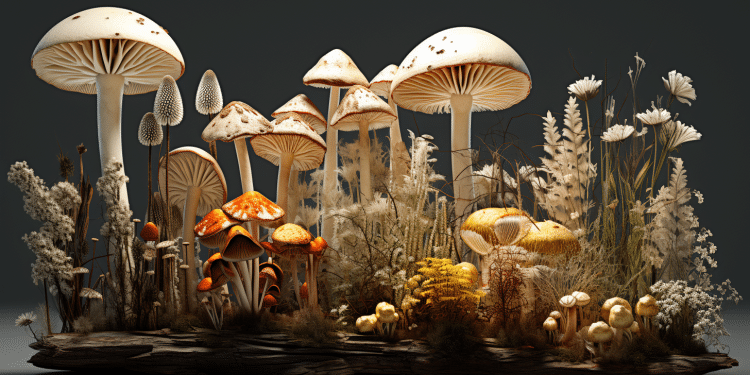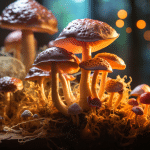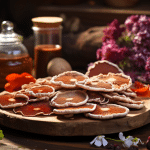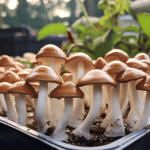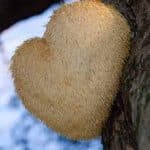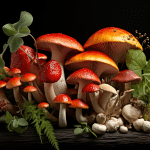Different Types of Hedgehog Mushrooms
Apart from hedgehog mushrooms, or sugar-treaters (Hydnum repandum), there are several other edible mushrooms that are often called hedgehog mushrooms. Here are some of the most popular and famous varieties.
The depressed or belly button hedgehog, Hydnum umbilicatum, is found throughout North America and Europe growing in bogs and marshes.
It is much like a sweet tooth hedgehog, but smaller and darker. Also, this mushrooms cap is more normal-shaped, with the center pressed down, similar to the stomach button, giving it the name.
Terracotta hedgehog: Its caps are rusty or earthen colors, more regularly formed, with the central stalk. On its lower side, its spines do not extend along the stem.
White hedgehog: It has white-to-pale gray fruit bodies with yellow-to-orange bruising, smaller in size than the sweet tooth. On the lower side, the white spines do not extend up the stalk.
Giant or spreading hedgehog: These are native to Central and North America. They have white spines on the underside that do not run along the stem. And have a pale grey or white-ish fruiting body that will bruise orange to yellow.
Some Hedgehog Mushroom Look-Alikes
Keep an eye out for these two hedgehog look-alikes.
Drab tooth (Bankera fuligineoalba)
The drab tooth mushrooms are inedible, but they are not toxic. It is found beneath the spruce, and is similar to a sugar teeth, except it has a brownish-colored crown and teeth. The cap is velvety instead of smooth, and often has a layer of pine needles and organic detritus attached.
Scaly hedgehog (Sarcodon imbricatus)
The Scaly Hedgehog is a similar looking edible, featuring a distinct raised, tan-colored cap. These mushrooms grow extremely large, and can grow as big as 12 inches (30 cm) across their caps. On the underside of their pale-brown-to-gray caps, they have spongy, pale gray teeth that are 0.2-0.6 inches (0.5-1.5 cm) long. Scaly hedgehogs are found August through October across Europe and North America growing in rings beneath fir trees. While these resembling mushrooms do have spines along their lower sides, they do not have the same smooth, creamy-white or salmon-pink caps.
So, they are not that hard to distinguish.
How to Harvest Hedgehog Mushrooms | Best Methods
It is good idea to have a knife handy when picking hedgehog mushrooms. While their stalks are easy to break off, cutting them off with your knife can help to cut down on the amount of mud or trash that gets in your bin. The base of a hedgehogs stem will often have soil attached that you cannot brush away easily. You can trim that part before placing your hedgehog mushrooms into the bin.
Or, if you would like to preserve as much of the tasty flesh as possible, take a knife and cut off the dirtier bits from the base of the stalk, just like you would cut a pencil. Also, if the stem is super-dirty the whole way up, scrape at it gently to get rid of as much of the mud as you can. But do this gently, because stems and caps are very brittle and can break very easily.
You want to minimize any mud getting in your hedgehog mushrooms teeth when you pick them. A basket full of hedgehog mushrooms covered with soil and trash is not easily cleaned.
How to Clean and Prep Hedgehog Mushrooms
Hedgehog mushrooms may be slightly harder to clean than other mushrooms, since the dirt and grit may be trapped inside teeth at the bottom side of the cap. Fortunately, hedgehog mushrooms are not attractive to insects and worms, so usually only dust and some sludge needs to be removed. To get rid of particles in the teeth, try holding a hedgehog mushroom at the stem end, then lightly tapping on the top of the cap. Larger particles will generally fall off. You can also gently brush dirt off your teeth using a fungus brush or a pastry cutter.
If they are not yet clean, a quick dip in a bit of cold water should do the trick, but it is rarely needed. Try not to leave mushrooms in the water for too long, because they can get waterlogged.
Some prefer scraping off the teeth from the mature prickly mushrooms, particularly if you picked them right after a rainstorm and there is lots of dirt trapped inside the teeth. To do so, gently press the teeth down with a thumb, then scrape or brush them away. If you are planning on parboiling and freezing your hedgehog mushrooms, there is no need to worry, since the teeth will drop off during cooking.
How to Store and Preserve Hedgehog Mushrooms
Hedgehog mushrooms have a longer shelf life, preserving nicely for two or three weeks in a refrigerator. Like other mushrooms, you should not store hedgehog mushrooms in an airtight container.
Paper bags are better than bags or plastic containers. Paper bags allow mushrooms to breath and soak up extra moisture, keeping them fresher longer.
If you end up with extra prickly mushrooms, you can roast or blanche them and freeze them for later. You can also dry the hedgehog mushrooms, but this is not recommended unless you are trying to make hedgehog mushroom powder, because their texture and flavor changes once rehydrated.
How to Cook and Eat Hedgehog Mushrooms
Hedgehog mushrooms have a number of tasty food applications as well as many health benefits. One of the best ways to enjoy hedgehog mushrooms is by frying them in butter or olive oil with a little garlic, then serving over steaks, or piling them onto toast. Like chanterelles, hedgehog mushrooms are also an excellent addition to soups. They are also excellent in tomato, white wine, or cream-based sauces, and are frequently used in casseroles, pot pies, tarts, and stir-fries. The tough flesh of the hedgehog mushrooms makes them perfect for pickling or canning, successfully preserving both their texture and flavor.
Nutritional Information and Benefits of Hedgehog Mushrooms
Hedgehog mushrooms are more commonly consumed for their nutrient benefits, since they are highly nutritious and a great source of iron for those who do not eat meat. They are low in fat and high in protein, with high levels of several dietary minerals, particularly copper, iron, and manganese. They are also good sources of magnesium, calcium and zinc.
The combination of nutrients in hedgehog mushrooms makes them useful in strengthening bones, regulating blood clotting and nerve function, increasing energy and protein levels in cells, and fighting viruses. Hedgehog mushrooms have a few medical benefits too, since they contain antioxidants which combat oxidative stress, so it may help to prevent cancer and cardiovascular diseases.
